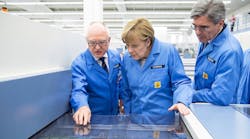Embattled German Industrials Pursue the Factory of the Future
The clanking, hulking factory in a rural patch of northwest Germany that produces 22-ton combine harvesters has lately been turning out machines with a technical edge. Claas Group, a 104-year-old, family-owned manufacturer of harvesters, threshers and tractors, is hunting for revenue by outfitting machines with sensors, cameras and software to help its products stand out amid slumping demand.
Low commodity prices have hurt farm equipment demand globally, and Claas does not expect sales to increase from the $4 billion made over 2016. Since combines only see action six weeks a year, Claas is trying to sell software as well as machinery: for the past year a package of GPS networking, grain-load sensors and smartphone software to choreograph the lumbering dance of combines and 40-foot wagons that haul away grain. Based on where the threshers are in the field and how full the loading wagons are, drivers can pinpoint where they’re needed next with a glance at a screen, saving time and fuel.
"They’re bigger machines and there’s more horsepower under the hood," said managing director Carsten Hoff. "The machines need to be smarter."
An old firm turning to technology to drag it out of a slump is hardly a new story. But for Germany, it’s a vital one. Consultancy Roland Berger predicts the value of Germany’s industrial sector could decline by 220 billion euros ($247 billion) by 2025 if it fails to update its computer and communications technologies and lets new competitors get access to its customers.
Chancellor Angela Merkel is urging Germany’s heavy industry to modernize--a policy dubbed Industry 4.0 (for "the fourth industrial revolution")--wherein the likes of BMW AG, Robert Bosch GmbH, Daimler AG, SAP SE and Siemens AG are investing billions of euros to defend the country’s world-leading automakers and machine builders from U.S. and Asian competition. That’s not even counting the thousands of midsized Mittelstand companies hoping to get on board and several hundred million euros invested by the government.
"Germany has focused on manufacturing first and completely transforming it," said Henning Kagermann, president of the National Academy of Science and Engineering (Acatech) and a former CEO of SAP. "This is the backbone of our success in Germany. How can we defend our businesses so if the top line drops by 30%, they can still make money?"
If any company embodies the attempt of an established industrial giant to propel itself into the future, it’s turbine, train and factory producer Siemens. The company is racking up sales gains in its Digital Factory division, which sells a range of plant automation equipment and software. The unit’s nearly 18% profit margin is the highest in the company, and Siemens’ pristine Amberg factory in Bavaria is a showcase for automated manufacturing.
A catwalk overlooks the massive 108,000 square foot production floor. Below, workers tend to robots and sleek machines producing more than 120 variants of Siemens’ circuit boards and controllers daily. Since the beginning of the year, a product developer can create a plan change in Siemen’s TeamCenter software and in the next moment send it right to the production line, rather than having to transmit files or paper plans. About 5,000 of these computerized changes are done a year. "Connecting the shop floor with the design office—that’s our strategy," said Jan Mrosik, CEO of the digital factory division.
Siemens is also looking into replacing overhead electronic boards that cue workers about next steps with augmented reality glasses, and the company’s researchers are working with Facebook Inc.’s Oculus Rift, a spokesman said. Digital glasses could also show the status of factory machines when a technician casts a glance at them.
"Siemens is the master of the factory floor," said Kepler Cheuvreux analyst William Mackie. About 75% of production at the Amberg plant is computerized--and production has increased nine-fold since the factory opened in 1989, without big increases in its workforce of 1,300.
Siemens still has problems--its profit margin has been in a slump for years and it finally got its stock price last year back to where it was a decade ago. General Electric Co. is aiming straight at Siemens with its industrial internet initiative. In February Siemens named former SAP co-CEO Jim Hagemann Snabe of Denmark as its next chairman to add software expertise.
By some metrics, Germany may be a touch paranoid about its need to modernize. A Boston Consulting Group study from last December of more than 750 industrial producers in autos, mechanical engineering, plant construction and process industries found 47% of German companies have put elements of smart factories in place, versus just 29% of U.S. manufacturers.
But there are unsolved problems with the future factories initiative that could leave Germany vulnerable. Many of the projects center on heading off maintenance problems through software-aided analysis of machines, or equipping repair technicians with tablets to speed fixes on the shop floor.
Those are easily copied by foreign competitors, said Guenter Korder, CEO of Intelligent Technical Systems of Ostwestfalen Lippe--known as It’s OWL--the public-private tech cluster that sponsored the Claas project. "This is only efficiency. That’s not radical," he said.
And while consultancies are pushing the Industry 4.0 concept hard to market their services, getting companies below the blue-chip tier to put cloud computing, collaborative robots or augmented reality in their budgets will be a slog. "The actual industrial base will take years to adopt this technology, longer than expected, because it’s extremely risky and they’re conservative," says analyst Mackie.
Bosch is targeting savings of 1 billion euros by 2020 and a further 1 billion euros in fresh revenue through new technologies. Its Feuerbach plant near Stuttgart started as a headlamp producer in 1914, switched to diesel injection systems in the late 1920s and survived World War II.
Today, near the production floor, a dozen workers huddle in a bare-bones conference room punctuated by a giant touch screen on wheels, one of 14 "Active Cockpits" Bosch developed for its plants. The workers review data from the shift that just ended; problem spots circled on the screen in red. The displays can also show a foreman how much time he’s lost each month on idle machines, workers out of place, or production problems.
Upstairs in cushier quarters, product manager Wolfgang Pomrehn shows the company’s APAS Assistant robot, designed for collaboration with humans. One of the robotic arms, clad in soft black plastic, can be wheeled to a workstation or mounted on a bench to work in close quarters with a person, speeding up when it’s left alone, slowing by five times when a worker is a half meter away, stopping when someone ventures too close.
Pomrehn’s group is working on new features for APAS that could help it read workers’ intent even if they miss a step, and he envisions the robots being deployed alongside refugees who are starting to enter Germany’s factory force. Two of the country’s biggest newspapers recently showcased one of the robots working alongside a disabled man at a maker of shower heads. It’s that kind of hopeful talk that’s being proffered as an antidote to the inevitable job losses in some manufacturing work that will be taken over by computers.
"There will be a structural change -- jobs will disappear and new jobs will come," said Kagermann. The Center for European Economic Research in Mannheim, Germany estimates 12% of German and Austrian workers risk having their jobs 70% automated -- the highest among 21 countries it studied.
Germany’s drive to modernize has created jobs for its robots, however. Festo, a $3 billion maker of industrial valves for auto and electronics manufacturing, boasts collaborative robots, has two Bosch APAS robots in a testing area at its Scharnhausen "learning factory" near Stuttgart in southern Germany. The idea is to roll them among stations this summer at high demand times or on weekends to lay valves on a storage board, according to Michael Voss, a Festo research engineer. But the robots can’t remove the valves from their plastic boxe —a person needs to do that.
The company, founded in 1925, is facing competition from SMC in Japan, AirTAC International in Taiwan and Parker PGI in the U.S., and invests 8% of sales in R&D, high for an industrial producer.
At another station, a Kuka white robotic arm half as tall as a man operates alongside a worker without a protective cage. The robot presses sealing rings into the valves then she takes over the finer work of screwing power units to valves.
It is not just the stereotypical German factories that are hell-bent on modernizing. In the northern region of Ostwestfalen Lippe, driving past small towns and farms, Merkel’s fourth industrial revolution is taking hold in unexpected quarters.
At WP Kemper, a family-owned supplier of bakery equipment for turning out the world’s loaves, donuts and Germany’s beloved Brötchen, CEO Michael Euler, surrounded by overflowing baskets of baked goods and urns of coffee, shows what may be the world’s first "intelligent kneading hook."
Kemper, which has 150 employees and annual sales of about $38 million, spent a million euros over three years on a project to build sensors into an industrial-sized bread hook.
The giant kneading machine connects to a computer running statistical analysis of the dough’s temperature, the torque of the bread hook and kettle, and kneading power. The machine adjusts itself depending on the texture of the dough, which in a few minutes achieves a perfect pleated form.
"Being a baker isn’t sexy," said Euler. "It’s about how through innovative products, small companies like us have a chance to compete."




